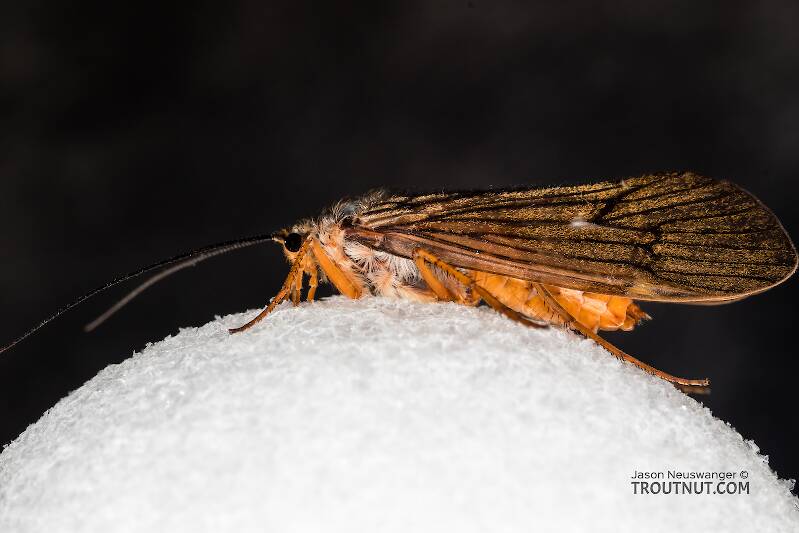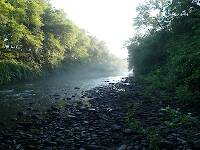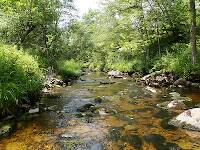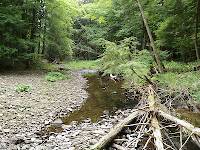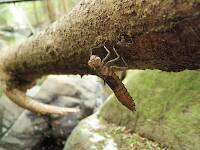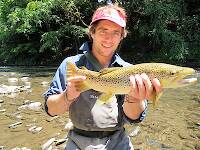
Hex Mayflies
Hexagenia limbata
The famous nocturnal Hex hatch of the Midwest (and a few other lucky locations) stirs to the surface mythically large brown trout that only touch streamers for the rest of the year.
Featured on the forum

It's only barely visible in one of my pictures, but I confirmed under the microscope that this one has a prosternal horn and the antennae are mid-way between the eyes and front of the head capsule.
I'm calling this one Pycnopsyche, but it's a bit perplexing. It seems to key definitively to at least Couplet 8 of the Key to Genera of Limnephilidae Larvae. That narrows it down to three genera, and the case seems wrong for the other two. The case looks right for Pycnopsyche, and it fits one of the key characteristics: "Abdominal sternum II without chloride epithelium and abdominal segment IX with only single seta on each side of dorsal sclerite." However, the characteristic "metanotal sa1 sclerites not fused, although often contiguous" does not seem to fit well. Those sclerites sure look fused to me, although I can make out a thin groove in the touching halves in the anterior half under the microscope. Perhaps this is a regional variation.
The only species of Pycnopsyche documented in Washington state is Pycnopsyche guttifera, and the colors and markings around the head of this specimen seem to match very well a specimen of that species from Massachusetts on Bugguide. So I am placing it in that species for now.
Whatever species this is, I photographed another specimen of seemingly the same species from the same spot a couple months later.
I'm calling this one Pycnopsyche, but it's a bit perplexing. It seems to key definitively to at least Couplet 8 of the Key to Genera of Limnephilidae Larvae. That narrows it down to three genera, and the case seems wrong for the other two. The case looks right for Pycnopsyche, and it fits one of the key characteristics: "Abdominal sternum II without chloride epithelium and abdominal segment IX with only single seta on each side of dorsal sclerite." However, the characteristic "metanotal sa1 sclerites not fused, although often contiguous" does not seem to fit well. Those sclerites sure look fused to me, although I can make out a thin groove in the touching halves in the anterior half under the microscope. Perhaps this is a regional variation.
The only species of Pycnopsyche documented in Washington state is Pycnopsyche guttifera, and the colors and markings around the head of this specimen seem to match very well a specimen of that species from Massachusetts on Bugguide. So I am placing it in that species for now.
Whatever species this is, I photographed another specimen of seemingly the same species from the same spot a couple months later.

Troutnut is a project started in 2003 by salmonid ecologist Jason "Troutnut" Neuswanger to help anglers and
fly tyers unabashedly embrace the entomological side of the sport. Learn more about Troutnut or
support the project for an enhanced experience here.
This topic is about the Insect Order Trichoptera
Some say caddisflies are even more important than mayflies, and they are probably right. The angling world has taken a while to come to terms with this blasphemy. Caddis imitations are close to receiving their fare share of time on the end of the tippet, but too many anglers still assume all caddisflies are pretty much the same.Caddis species actually provide as much incentive to learn their specifics as the mayflies do. There is just as much variety in their emergence and egg-laying behaviors, and as many patterns and techniques are needed to match them. Anglers are hampered only by the relative lack of information about caddisfly behavior and identification.
Example specimens
Dryfly on Dec 18, 2009December 18th, 2009, 3:27 pm EST
I have a basic understanding of caddis fly IDing when it comes to the larva, but how do you tell the adults apart. You can never have enough useless bug knowledge. :)
Creno on Dec 18, 2009December 18th, 2009, 3:51 pm EST
from a fishers perspective start with Thomas Ames' new book Caddisflies. If that is not enough for ya let me know and I will find whatever is good at that time. Depending on what you want you may not need any more than Ames' book.
creno
creno
Creno on Dec 19, 2009December 19th, 2009, 4:56 am EST
If you would rather use a pc than paper, here is an interesting approach I forgot about. http://www.entomology.umn.edu/museum/projects/keys/
Ralph Holzenthal's UofMN site has lots of other useful information for folks interested in caddis and is updated fairly frequently.
Ralph Holzenthal's UofMN site has lots of other useful information for folks interested in caddis and is updated fairly frequently.
Quick Reply
Related Discussions
Topic
Replies
Last Reply


